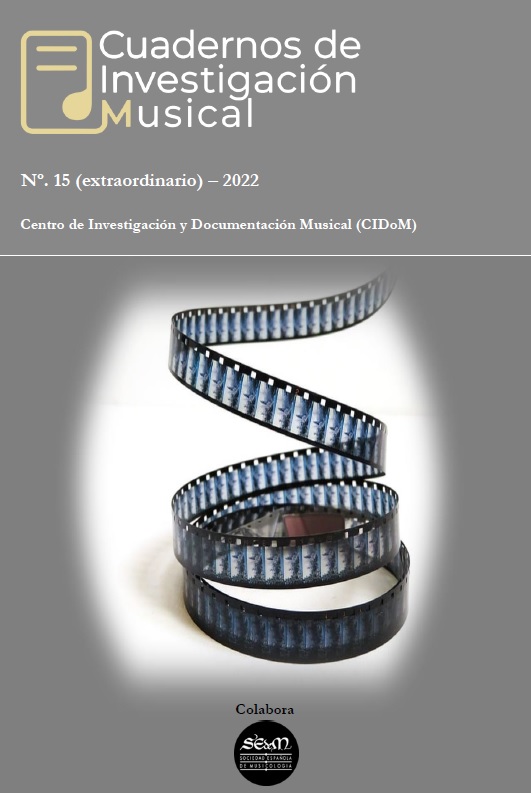Music and politics in Hanns Eisler’s film music
Main Article Content
Abstract
This article presents a double itinerary: on the one hand, it approach the crossover between musical culture and the crisis of bourgeois society in the thought of Hanns Eisler, published in Musik und Politik (1973, 1982 and 1983). On the other hand, his music will be considered mainly in Kuhle Wampe (Slatan Dudow, 1932) and Hangmen Also Die! (Fritz Lang, 1943). The choice of examples is due to the following reasons: the first one dates from the year before the rise of Nazism, which allows us to trace the line of work prior to the American exile and is nourished by Eisler's experience in Berlin, deeply influenced by the workers' struggle and, specifically, his participation in the workers' choirs. The second was shot in Hollywood, while Eisler was working with Adorno in the Film Music Project (financed by the Rockefeller Foundation). Both examples allow us to trace the practical drift (and its possible deviations) of his political commitment.
Article Details
Los autores de los artículos mantienen el copyright, no recibirán ninguna contraprestación económica por el trabajo y el mismo siempre será reconocido como exclusivamente suyo. La revista se compromete a proteger la integridad y originalidad del artículo, así como los derechos de autor que correspondan. Los autores son los únicos responsables del material, textos e imágenes que utilizan en sus respectivos trabajos, debiendo respetar siempre los derechos de autor de terceras personas, por lo que la revista no se hace responsable de lo contenido en este tema respecto al trabajo de los autores.
References
Adorno, T. W. y Eisler, H. (2007). Composición para el cine. El fiel correpetidor. Madrid: Akal.
Betz, A. (1976). Hanns Eisler. Musik einer Zeit, die sich eben bildet. Munich: Edition Tex+Kritik.
Bick, S. (2010). A Double Life in Hollywood: Hanns Eisler’s Score for the Film Hangmen also Die and the Covert Expressions of a Marxist Composer. The Musical Quarterly, 93(1), 90-143. https://doi.org/10.1093/musqtl/gdp026
Bick, S. (2020). Unsettled Scores: Politics, Hollywood, And The Film Music Of Aaron Copland And Hanns Eisler. Urbana: University of Illinois Press.
Brecht, Bertolt (2000). Brecht on Film and Radio. M. Silberman (ed.). Londres: Bloomsbury.
Cage, J. (1961). Silence. Lectures on Nothing. New England: Wesleyan University Press.
Danuser, H. (2009). Weltanschauungsmusik. Schliengen: Argus.
Dowe, D. (1978). The Workingmen’s Choral Movement in Germany before the First World War. Journal of Contemporary History, 13(2), 269-296. https://doi.org/10.1177/002200947801300206
Eisler, H. (1973). Musik und Revolution. Schriften 1924-1948. Leipzig: VED.
Eisler, H. (1982). Musik und Revolution. Schriften 1948-1962. Leipzig: VED.
Eisler, H. (1983). Musik und Revolution. Addenda. Leipzig: VED.
Engelhard, J. (1975). Eislers Weg vom Agitprop zum Lehrstuck. Das Argument (5), 1975, pp. 91-110.
Gorbman, C. (1991). Hanns Eisler in Hollywood. Screen, 32(3), pp. 272-285. https://doi.org/10.1093/screen/32.3.272
Jackson, M. R. (2003). Workers, Unite! The Political Songs of Hanns Eisler, 1926-1932. Tesis doctoral. Florida State University.
Koutsourakis, A. (2015). “The Crisis of the Individual as a Precept of Political Cinema: "Kuhle Wampe" (1932) and "Monsieur Verdoux" (1947)”. Film Criticism, primavera, 2015, 39 (3), pp. 26-47.
Kuhnke, K. (1979). Hanns Eisler. Notes, 36(2), 507-507. https://doi.org/10.2307/940242
Sicks, K.-M. (2004). Sollen Dichter boxen? Brechts Ästhetik und der Sport. Hofmannsthal Jahrbuch zur europäischen Moderne 12: pp. 365-404.
Wittich, M. (2017). On Workers Singing in One Voice. En I. Kacandes (Ed.). (2017). The proletarian dream: Socialism, culture, and emotion in Germany, 1863-1933. Berlin: Boston: Walter de Gruyter.
Zetkin, C. (1955). Über Literatur und Kunst. Berlín: Henschelverlag.
